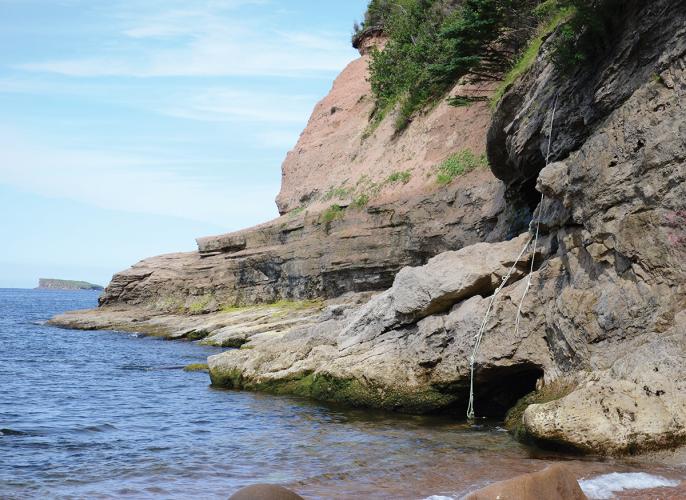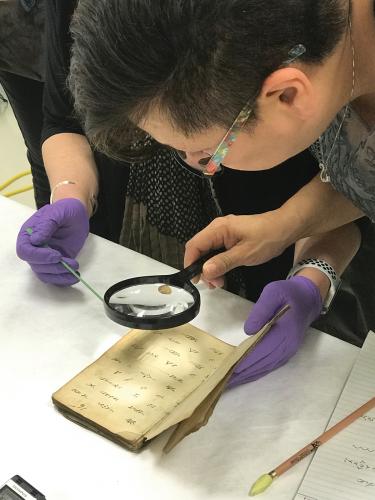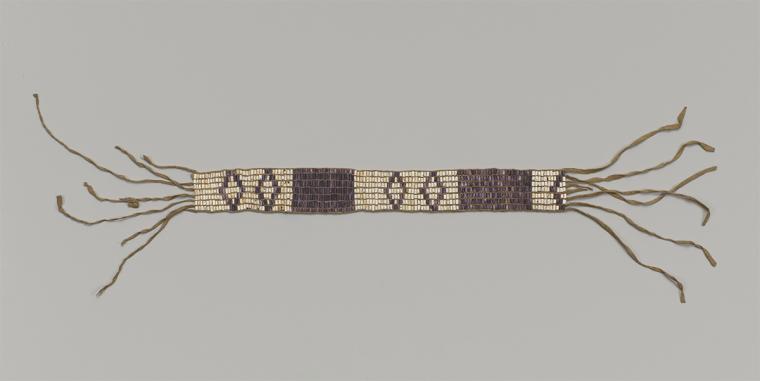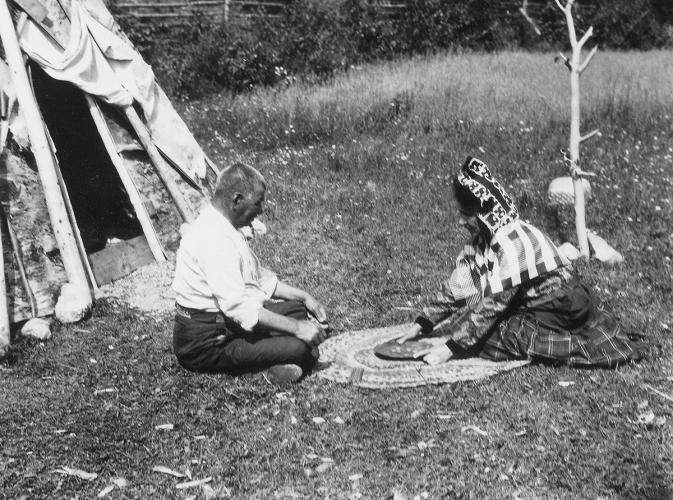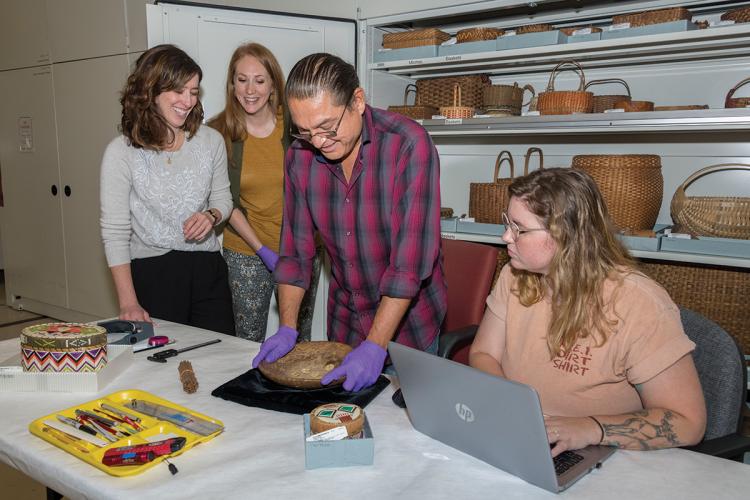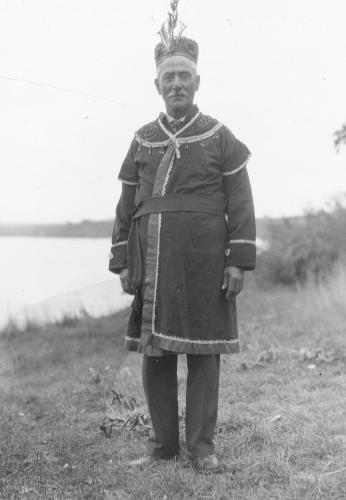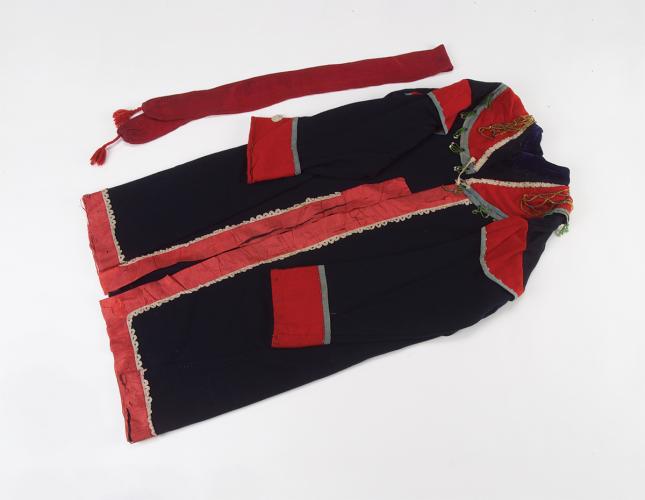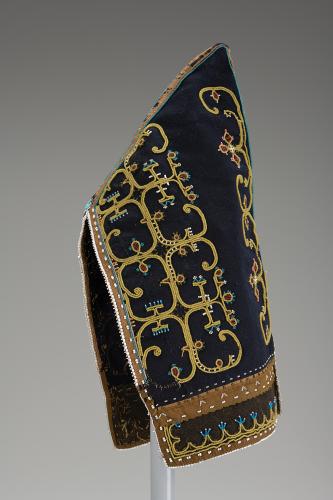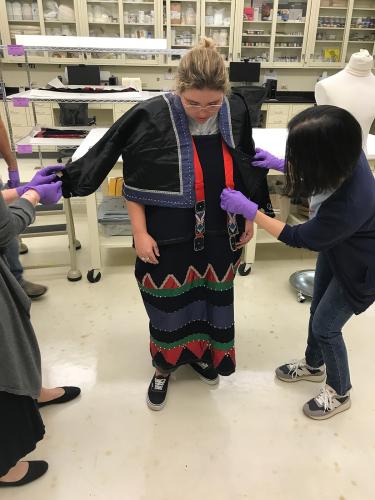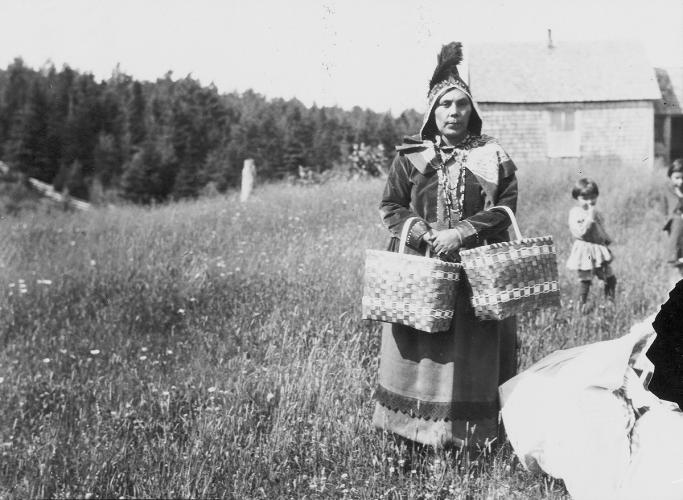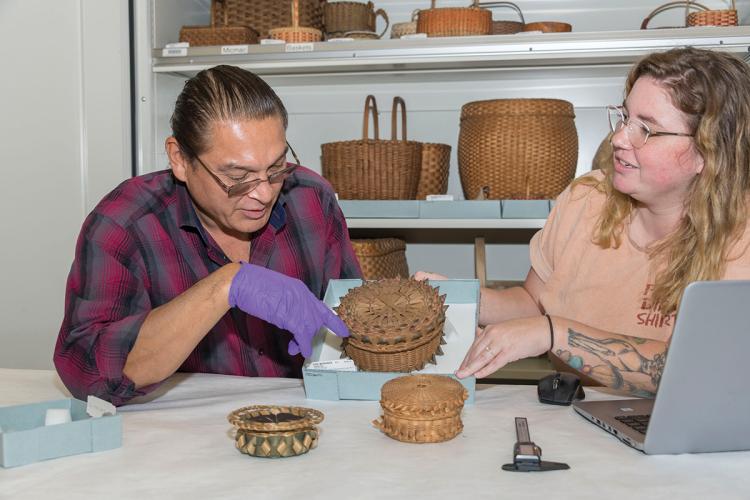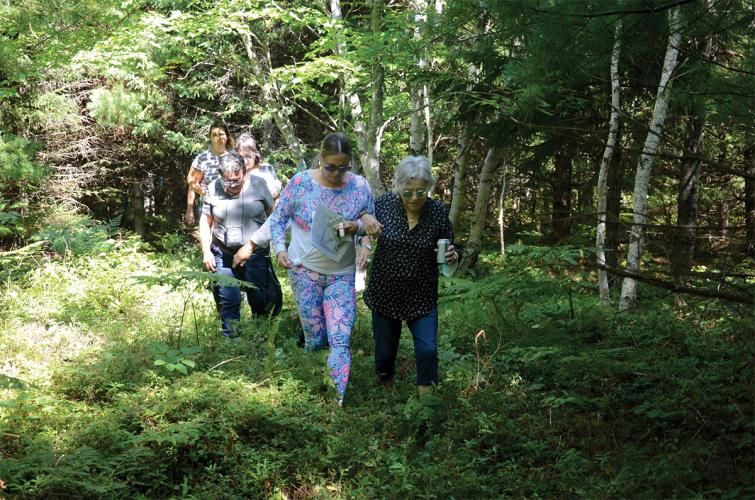On the north coast of Nova Scotia is a cave known to the Mi’kmaw people of Canada as the center of the universe. Tucked into a rocky cliff above a remote beach off Cape Breton, this portal is where the Mi’kmaw cultural hero Kluskap walked from this world into the next. Getting to this sacred place is a difficult trek. One must scramble down a steep ravine, traverse a stream and then scale a cliff to reach it, yet many still choose to make the pilgrimage. “It challenges you physically, mentally, emotionally and spiritually,” said Clifford Paul, a Mi’kmaw wildlife manager at the Unama’ki Institute of Natural Resources. But, he said, “Once you get there, you feel that you have walked the path of your ancestors.”
That connection to homeland, or Mi’kma’ki, and to each other, or Lnu’k, is at the core of Mi’kmaw worldview. Tangible items such as a basket a grandmother decorated with sweetgrass, a cradleboard that carried a great aunt or even the tool that an uncle used to carve a wooden figure can serve as a bridge between these Indigenous peoples and their ancestors.
During the past century, when collectors and museums removed items from Mi’kmaw communities, many of those links were broken. The National Museum of the American Indian has been working with the Mi’kmaw Nation for the past two decades to help heal that gap and bring the Mi’kmaw peoples’ objects in the NMAI collection back to share with their communities. Now that goal is becoming a reality, as the Mi’kmaw’s items are destined for the new Mi’kmawey Debert Cultural Centre (MDCC) being built in central Nova Scotia.
Mi’kma’ki’s Extensive Reach
The Mi’kmaw territory has 35 communities whose homelands, or Mi’kma’ki, stretch across what is now Canada’s Nova Scotia, Prince Edward Island, New Brunswick, Newfoundland and Quebec. They have lived here for at least 11,000 to 13,000 years, as indicated by radiocarbon-dated charcoal recovered from ancestral sites located in Debert in the center of Nova Scotia. Archaeologist George MacDonald led the excavations of these sites during the 1960s, when he was pursuing his doctorate at Yale University. While the excavations yielded information about Mi’kmaw history and culture, they also took it away, as many of the items found there ended up in museum collections.
Seventeenth-century French explorers and missionaries recorded some of the earliest accounts of the Mi’kmaq. Many people have mistakenly referred to them as “Micmac,” instead of Mi’kmaq (pronounced “meeg-mag”), and that misspelling is still seen today in some signage and archival records. Anthropologist Wilson Wallis visited Mi’kmaw communities from 1911 to 1912 and again with his wife and fellow anthropologist, Ruth, from 1950 to 1953. Together they wrote an extensive account of these communities in their 1955 book, “Micmac Indians of Eastern Canada.” Many of the objects they obtained during that time are in the NMAI collection.
The key to connecting those items to Mi’kmaw families today, however, was a collection of photographs that young researcher Frederick Johnson made from 1930 to 1931, when he spent extensive time in seven Mi’kmaw communities in Nova Scotia and Newfoundland. He recorded some 200 images of Mi’kmaw people and everyday life in Mi’kma’ki. As the Museum of the American Indian, the predecessor to NMAI, had sponsored some of Johnson’s research expeditions to Indigenous communities in Canada from 1924 to 1931, several of Johnson’s images are in the NMAI archives. Copies of the photographs were also in the Robert S. Peabody Museum of Archaeology in Andover, Massachusetts. The Mi’kmaw Nation first learned of the image collection in 1997, when Leah Rosenmeier, who was then an outreach and repatriation coordinator at the Peabody museum, encouraged Cynthia Martin to bring them back and share them with her Mi’kmaw community of Millbrook.
From these images, Catherine Martin (Millbrook First Nation), Elder Murdena Marshall (Eskasoni First Nation), Donald Julien (Millbrook First Nation), Tim Bernard (Millbrook First Nation) and Rosenmeier created an exhibition that toured various venues, including the Nova Scotia Museum and the Canadian Embassy in Washington, D.C. These photos were also featured in a book the confederacy and Peabody museum co-published called “Mikwite’lmanej Mikmaqi’k: Let Us Remember the Old Mi’kmaq.”
The desire to protect the Mi’kmaw ancestral sites that had been excavated sparked an even larger idea: Donald Julian, who was then the executive director of the confederacy, proposed that the Mi’kmaw Nation could have its own museum where images of their communities such as the Johnson collection and Mi’kmaw items could be displayed. The confederacy soon began planning the Mi’kmawey Debert Cultural Centre to be built near the former excavation sites and reached out to NMAI to ask if they could bring the Mi’kmaw items in those collections home on a long-term loan.
A Language of Doing
One idea the center will reflect is that language provides a gateway to Mi’kmaw ways of knowing and being that is central to sharing Mi’kmaw history and interpretation. In addition to oral storytelling, before European contact, they used other forms of communication. Mi’kmaw petroglyphs can still be found carved into stone in the town of Bedford near Halifax and Kejimkujik National Park and National Historic Site in southern Nova Scotia. Histories of the Mi’kmaq Grand Council and treaties with other nations were also recorded in shelled beads, or wampum, that were sewn into images on a belt.
Later the Mi’kmaq developed a written language that expressed their unique use of words. Unlike western languages that often simply have a name for an object such as “book,” their language “is very verb based,” explained Basil Johnson, who is a fluent Mi’kmaw speaker from the Potlotek First Nation. For example, the game played by throwing eight etched bone dice called wapinaqn is “the game you would play until the sun came up,” and a similar game where six dice are tossed as a wooden bowl is slammed on the ground or a table is called “waltes,” which means “to land,” as in the dice are landing in the bowl.
In 2018, language specialists working with the MDCC came to see the collection at NMAI’s Cultural Resources Center in Suitland, Maryland. Because the Mi’kmaw language is centered in “doing” and “process,” the words for the objects often took the form of “the thing that does this motion or action.” Understanding the collections through Mi’kmaw worldview changed how the MDCC staff thinks about curation, pivoting from an object-centered approach to a practice-centered approach. “At the MDCC rather than curating baskets, we curate basketmaking,” explains Rosenmeier, who now serves as a research and interpretation specialist for the MDCC. This outcome has affected all subsequent work in the partnership with the NMAI.
Caitlin Mahony, an NMAI conservator who is managing the project, said that this approach has changed the survey of the items. “Our survey structure emphasizes the relationship of the item to practice and associated communities rather than its form or material, which is common in museums,” she said.
The MDCC hired Kamden Nicholas, a member of the Pictou Landing First Nation, as well as Basil Johnson as curatorial associates in collections and education, respectively. They left their communities to dedicate eight months at NMAI’s Cultural Resources Center, examining every Mi’kmaw item in the collection. “Actually getting to see and put your hands on items that are part of your cultural heritage and history means so much, “ said Basil Johnson. Working collaboratively with conservation fellows and interns, the condition of each item was assessed and documented. It was also given a comprehensive description that includes its associated Mi’kmaw language terms and suggestions of how it can be used within the future center.
This information will travel with their items to the MDCC. “One of our end goals is to have our own lexicon and naming conventions,” said Nicholas. “Being wrapped in community knowledge is what keeps [these objects] alive,” added Rosenmeier.
A Tangible Connection
Each visit to the NMAI collection has yielded discoveries and conjured up memories. “The first day walking in you could just feel the energy from everything,” recalled Basil Johnson. When Nicholas’ great-aunt Sarah Francis (Sadie), who is a member of the Elders’ Advisory Council, picked up a birchbark container with visible spoon scrapes, “she felt like she was cooking with her parents, and she could taste the food that they were cooking.”
During the MDCC project, items in the NMAI collection have been matched with those seen in the Frederick Johnson images, such as the coat and hat that Tom Gloade wore as he posed for his portrait. Elder Madonna Johnson (Eskasoni First Nation) and Nicholas were even able to put on the skirt and jacket worn by Charlotte Wilmot of the Millbrook First Nation as she posed for Johnson’s photo nearly a century ago. Because of those images and the NMAI’s careful records, visitors have even found items belonging to their own families. Lillian Marshall, who visited in 2012, held a hat that was worn by her aunt.
“The fact that the Mi’kmaw items in the collection can be directly connected to living family members is notable,” said NMAI’s Head of Conservation Kelly McHugh. “Research conducted by the community to restore these connections is critically important.”
A Shared Stewardship
Now that the assessment of the items is completed, in the next phase of the project MDCC staff will bring practioners—beadworkers, basketmakers, quillworkers and others to the NMAI to guide and possibly address any treatment needed to prepare the items for their final journey home. Once there, the Mi’kmaw community will continue to care for them. This partnership between the NMAI and the MDCC is an exemplary example of shared stewardship, a policy implemented by the Smithsonian Institution in April of this year.
As McHugh said, “We recognize expertise lives in the community, and once the items are home, we know the relationship between us will continue and evolve.” Rachel Shabica, NMAI’s supervisory registrar who has helped coordinate the project, agrees, “The MDCC have been excellent partners and we are already working on plans for our work together to continue.”
When the items do voyage home, “We will be caring for this collection as a nation,” said Tim Bernard, the current MDCC executive director. “We couldn’t applaud NMAI more for their commitment to returning these objects,” said Rosenmeier.
The design for the Mi’kmawey Debert Cultural Centre is well underway, and the building is expected to be completed in 2025. In addition to a place where Mi’kmaw community members can be with their ancestors’ items, the cultural center will reflect their worldview and connection to each other and their lands. It will have four galleries with immersive exhibitions through which members of the public can experience Mi’kmaw culture through storytelling, language, art, song and dance. Visitors can also learn about how historic traumas are still impacting the Mi'kmaq today and yet they remain resilient. On the center’s grounds will be multiple self-guided trails that will lead into the nearby forest.
Like Kluskap Cave, the center will be a place for all to pilgrimage, and perhaps just in time. “Knowledge is in community. If we didn’t act when we acted, that knowledge would have been lost in time because those knowledge holders who carried that information would not have been there to engage with us,” said Bernard. “When we have an opportunity to use material that was created by ancestors and share them with the youth today, it connects them to those resources.”
The Elders’ Advisory Council described its vision of the museum as “a grandmother’s nest, where all living things are gathered and shared. We expect it to be a place where the past is relived, explored and validated.”

